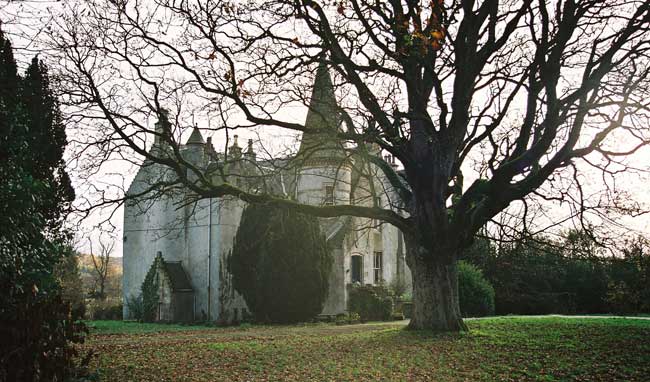Garrion Tower
(front aspect)

Garrion Tower
The photograph above of Garrion Tower was taken on Wednesday 17th November 2004, which was during Doris and my five day visit to Scotland. We stayed with Jim and Janette Brownlee, who live in the nearby village of Waterloo. Thanks to the hospitality of Jim and Janette and George and Eileen Russell, we toured all the main Brownlee sites. It was a dream come true for us and in particular for myself, as I had been looking at the names of these places on old Scottish maps for some 35 years or so, always dreaming of the day that I could see these places in real life.
The lands that Garrion Tower reside on go down to the banks of the Clyde and just a mere stone's throw away are the remains of the Brownlie's Garrion Mill, along with the new and old Garrion Bridge. The Brownlie cottages also line the road leading to the old Garrion Bridge on the Garrion side and the Brownlie miller's house is perched on the hill overlooking the ruins of Garrion Mill.
The following extract, from A Historical Sketch of the Parish of Cambusnethan by Margaret M. Colville, Wishaw, will give you a background to the property.
"Another place of historical interest is Garrion where, up till about the year 1925, a tumulus existed. This mound was marked by a single oak tree, and could be seen on the right side of Garrion Bridge. During last century a new road was being made at Garrion, and the stones of which the mound was built were thought suitable for road metal. For this purpose part of the tumulus was removed. However, it was discovered that the mound had been an old burial place and within it stone coffins were concealed. When this information was conveyed to the landowner at Coltness, he ordered the mound to be closed and for many years his commands were obeyed. About six years ago the mound was removed, and during its removal there was a terrible storm. This apparently confirms an old superstition which existed in Overtown village to the effect that the mound was a sacred place and if ever an attempt were made to damage it a terrible storm would sweep the country. *
*There are still people living here who record that several times, when men were attempting to remove the tumulus, thunder and lightning scared them from their work, and it is even said that some of the men who were at the work were killed by the lightning.
Another place of antiquity in this parish Tower, which is built near to the tumulus — a little to the south and nearer the margin of the Clyde. Of late years this antique building has been screened from the public view by the erection of modern buildings. The Tower itself has been repaired and is now a mansion. Previous to the renovation there was nothing peculiar to distinguish the Tower from the small baronial towers which apparently were very common in the South of Scotland. Few of these remain, as during the last century they have been allowed to fall into ruin.
The date of the erection of Garrion Tower has been a much disputed question. Historians are agreed, however, that it has stood for centuries and up till the Reformation it was a favourite summer residence of the Archbishops of Glasgow. On the surface it will seem strange that these religious men came to Cambusnethan, but the explanation is a simple one. During the early centuries the barony of Cambusnethan was under the control of the Bishop of Glasgow, and the Church in this district was called a mensal kirk, that is, a kirk which had to provide for the personal expenses of the bishop, and especially for the maintenance of his table. In those days, owing to bad roads, transport was difficult and expensive and goods going from Cambusnethan to Glasgow would be none too fresh for the bishop’s table, and to act over the difficulty the bishop himself came to Cambusnethan and resided in Garrion Tower, and all the expenses of supporting him there were met from the Church revenue."